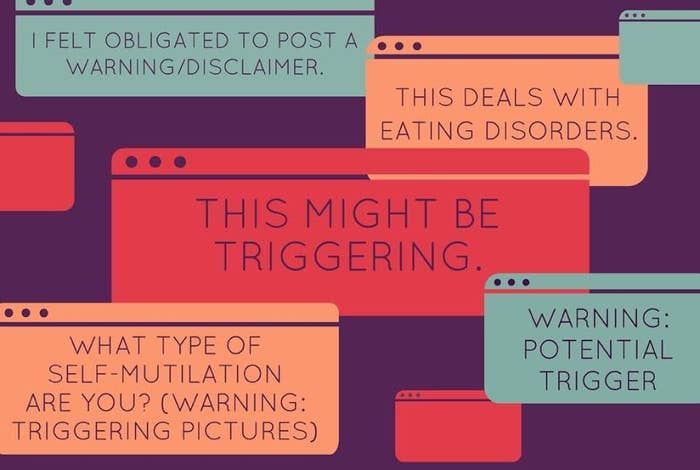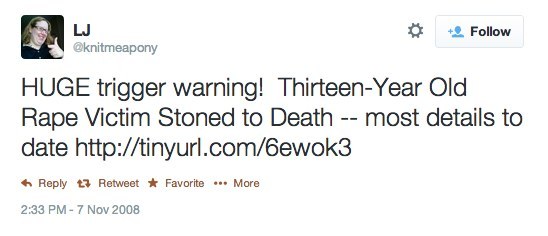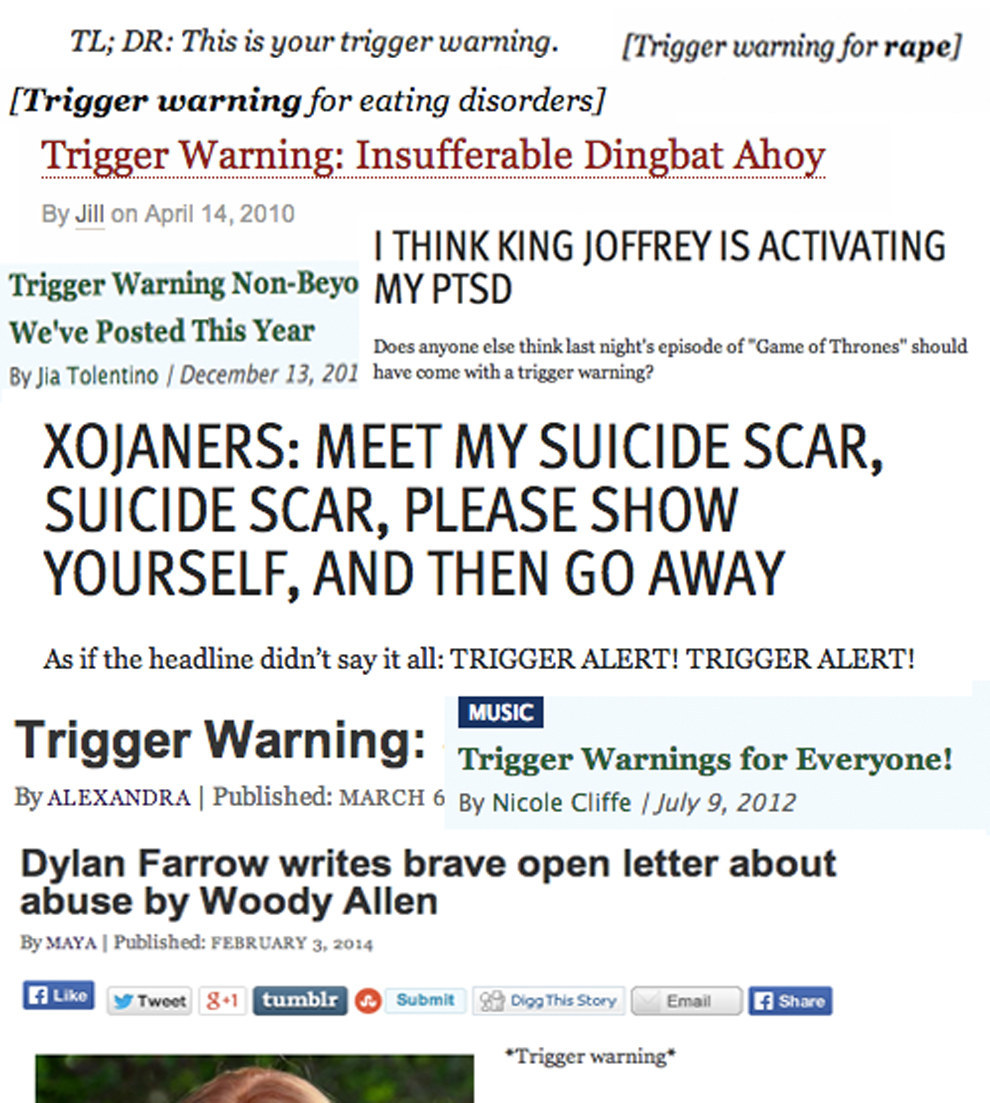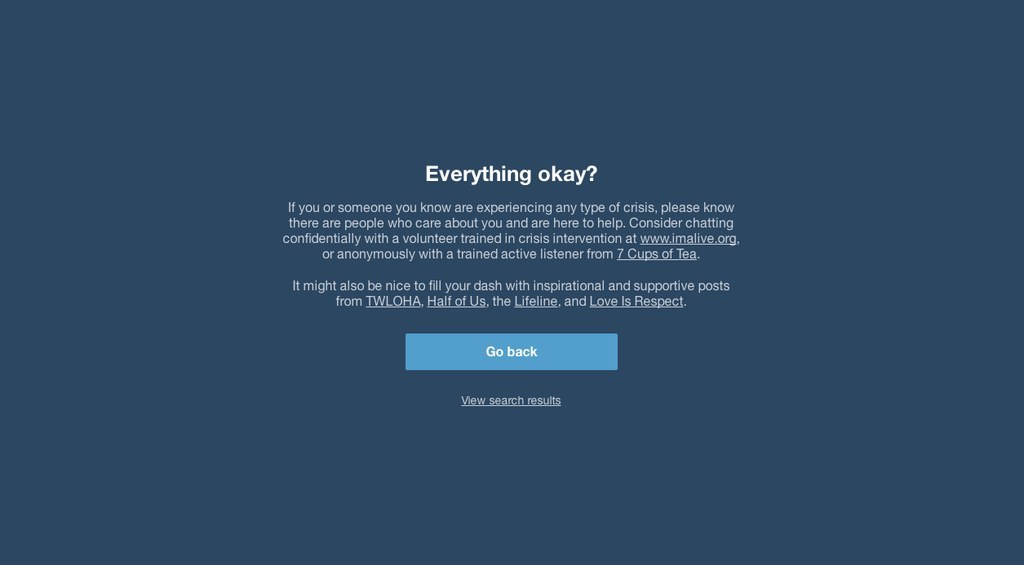
Scroll through Tumblr, search on Twitter, or glance over almost any feminist blog and you're bound to stumble upon the "trigger warning," a bold introductory statement alerting readers that unsettling content follows. An R rating. A red flag in an otherwise chaotic and unpredictable internet that suggests the text may unearth traumatic memories within you, or bring you back to that pinnacle moment when your life was divided into "before" and "after."
The clinical notion of triggering dates back far as 1918, when psychologists tried to make sense of "war neurosis" in World War I, and later World War II, veterans. The term "post-traumatic stress disorder" came into use after the Vietnam War, but was not recognized as a diagnosable affliction until 1980. Then, psychologists started to work with clients to identify possible PTSD "triggers," or a sensory input that somehow resembles the original trauma. But anticipating them is notoriously difficult. They assume disparate and unpredictable forms. An essay, or film, or other piece of media might trigger a person, as could a sound or a smell, a physical space, a specific object, or a person.
The digital response, the term "trigger warning," is now everywhere. It is common on feminist websites from xoJane to The Hairpin, and has been debated in a number of mainstream publications that have never even adopted the phrase, from The Guardian to the Associated Press.
This has happened as sexual assault becomes a larger part of the national conversation: Last week the White House released anti-rape PSAs and launched a task force for better responding to sexual assault on college campuses. And the term trigger warning has adapted too. It has now moved offline and onto college campuses, where some students are asking for trigger warnings on class syllabi.
Of course, content warnings on media existed prior to the internet: There's the graphic-content warning before a television show or a video game, or the rating system for movies. But where did the phrase "trigger warning" come from, and how did it dominate the internet and inch into our offline lives?

Tracking down the first time the phrase "trigger warning" appeared on the internet proves nearly impossible, but it's clear that the term did not enter the web fully formed. Before the "trigger warning" became the accepted way to brace readers for explicit content, bloggers prefaced stories with "This might be triggering," or "This deals with some eating disorder stuff," or "Warning: potential trigger."
Some version of the term began appearing on feminist message boards in discussions of sexual assault in the late '90s. Andi Zeisler, the co-founder and editorial/creative director of the feminist publication Bitch magazine, said the phrase often popped up on a community forum on Ms. Magazine's website.
"The first time I saw trigger warnings used was on Ms. Magazine's bulletin board in the late '90s and early '00s," she said. "It might have been on other feminist sites, but I only remember seeing it on Ms."
By the early 2000s, the term had found its way to LiveJournal, where it was used on fan fiction.
Gaby Dunn, a writer and early adopter of Tumblr and LiveJournal, said when she was using LiveJournal around 2001, fan fiction communities warned one another of explicit content but seldom used the phrase that has been adopted today.
"When we'd write fan fiction on LiveJournal, we might say, 'This includes a rape storyline,' or something, but that phrase ['trigger warning'] was never used," Dunn said.
The concept of triggering wasn't just applied to fan fiction; other users in recovery from addition or self-harm began to use it around the same time. On LiveJournal, some iteration of the trigger warning was first posted in 2002, according to the site's public archive. A user warned her followers that she was "pro-ana," and a commenter asked what that meant. The author explained:
It pretty much just means that there are eating disorder-related entries in my journal that are considered triggering to anorexics and bulimics that are in recovery from the disease. I felt obligated to post a warning/disclaimer.
Another post from 2002 asked users to "be courteous and use an lj-cut with a warning in the text before any possible triggers [for self-harm]." (An lj-cut allows you to hide all or part of your entry behind a link.)
The actual words "trigger warning" gained traction on the website a year later. A version of the phrase was used in the title of a July 2003 post that spread across the website, and is still archived on LiveJournal, called "What Type of Self-Mutilation Are You? (Warning: Triggering Pictures)."
In the years that followed, between 2003 and 2007, the exact phrase "trigger warning" appeared in blogs and in comments on LiveJournal 62 times, according to the site's archives. Some are on posts about rape, others eating disorders, and some reference what triggered users in their offline lives. And hundreds of other posts contain notes warning readers about potentially triggering content by using slightly different language.
While warning for triggers became expected in these specific communities, the advent of Twitter in 2006 and Tumblr in 2007, and the growth of Facebook in 2008, mainstreamed the term in a new way. People who used trigger warnings on their personal blogs began sharing content on Twitter and Facebook with the signifier:
has posted a new blog entry "Why are female rapists a joke to Hollywood? (Trigger Warning)": http://jameslandrith.com/content/view/3269/79/
Others shared links on Twitter with a trigger warning, even when the actual article did not use one:

Trigger warnings thrived on Tumblr too.
Tumblr's interface, in which users scroll through an endless dashboard of blogs, offers no warning — not even a headline — for potentially NSFW or triggering material. There's no choice of whether or not to click. The content is just there, and the purveyors of its omnipresent porn GIFs and Benedict Cumberbatch fan fiction don't care if you're at your office. Perhaps because of this, and the fact that many LiveJournal bloggers were early Tumblr users, trigger warnings became a common courtesy when the site began in 2007.
Tumblr's interface influenced the need for trigger warnings as much as its content did, as the site quickly grew popular among fan groups, feminists, the LGBT community, and teens. Articles that did not include trigger warnings in their original form were reblogged on Tumblr with the phrase. There is even a FuckYeahTriggerWarnings Tumblr. So bloggers began to expect the warnings, and when they ventured to other feminist sites, many started requesting trigger warnings in comments.
"It doesn't set off any triggers for me, but others may disagree," one Feministe commenter warned on a 2008 article that did not include a trigger warning. In an article a couple years later, a commenter requested a trigger warning for eating disorders after Jill Filipovic, an editor for the site, wrote that a piece of sexist legislation was "so awful it made me want to throw up."
Feministe then became the first website to share a story on Twitter with a trigger warning, according to search results from Topsy, a website that searches and analyzes Twitter archives.
Feministe officially introduced trigger warnings in 2008, "based on feedback from commenters," said Filipovic. "We obliged to users' demands because we did not want to alienate any readers."
But some posts prior to 2008 warned of disturbing content. A post titled "Would You Rather" from February 2006, for example, read: "(Note: contains some sexual-violence triggers)." Another post from July 2007 warned: "this video is potentially triggering."
Zeisler of Bitch, who started using trigger warnings in 2007, said she also began using the term based on commenter's requests. The print edition of the magazine, however, has never used the expression.
"Online spaces are often more curated for an imagined specific group of people. They're a little more narrowly focused, and there is a sense that they are cultivating a community," said Zeisler. "People who read and comment have a stake in the life of that online community, so it makes sense to respect what they want and think about the reading experience other people will have."
Like its counterparts, Feministing, which rose to popularity in the feminist blogosphere in 2009, adopted the phrase based on requests.
"Feministing respects such requests [from comments] by including trigger warnings on posts when we cover issues related to sexual assault, rape, or other violence, or publish posts with graphic content related to these themes," said Lori Adelman, the site's executive director. "We strive to create an accountable space online," which, among other things, includes "acknowledging when others are triggered."
Melissa McEwan, founder and writer of the popular feminist blog Shakesville, began using trigger warnings in 2009, five years after she first founded the site. She wrote about feminist subjects in the blog's early days, but McEwan says that readers weren't demanding trigger warnings with the same frequency. The rise of social media changed that.
As a survivor of rape, McEwan understood the desire to see trigger warnings before graphic content related to sexual assault, but she originally excluded the notes when writing about other subjects, like racism, ableism, colonialism, depression, or eating disorders. When readers started to ask for trigger warnings on those posts too, she was happy to add them.
After about two years of using trigger warnings, McEwan ditched the term in favor of her own system, which she calls "content notes." Similar to trigger warnings, the notes detail what topics will be discussed in each post.
"We switched to content notes in 2011 or 2012 to acknowledge that even if somebody isn't triggered, there still might be something that they don't want to read," McEwan explained. "Another issue that's been brought up is that the word 'trigger' might be triggering for people who have experienced gun violence."
Other sites have developed their own system too; Bodies Under Siege, a self-injury support message board, uses abbreviated tags — from SI (self-injury) to ED (eating disorders) — to offer warnings on particularly triggering posts.
These days content notes are found on nearly every Shakesville post, even on photograph of McEwan's dogs where their teeth are "bared in a way that may be perceived as aggressive." She added that one at the request of a man who had suffered from a dog bite. No harm comes from tellings readers what content to expect in a post, she believes.
The trigger warning has taken on a life of its own, flooding the feminist blogosphere and becoming an expected courtesy.
"You're sort of seen as a jerk if you're writing in a feminist space and not using trigger warnings," said Filipovic. "You now see them applied to racism, anything that is anti-transgender, anything that is bigoted, ablism. The word 'crazy' could merit a trigger warning … There's this feeling: 'How many problematic things can I point out about this article to show that I am a feminist, or the most able to identify all of the problematic language?'"
The term has also moved beyond the feminist community: It is still used throughout fan fiction and became the norm on the website AO3, an archive of fan literature, in 2009. A spokesperson for the site, Claudia Rebaza, said, "It's quite possible that discussion of triggers took place in fan spaces before the terms were more widely recognized ... the concern about warning for content was widespread enough among fan work creators that it was built into the AO3 posting format [in 2009]."

As the term grew increasingly ubiquitous online, it also began to acquire critics. In 2010, writer Susannah Breslin wrote that feminists applied the phrase "like a Southern cook applies Pam cooking spray to an overused nonstick frying pan" and that "the whole world is a trigger warning," to which Feministing responded that she was a "certifiable asshole," and Jezebel, a site that has never used trigger warnings, claimed that the debate over the term "been totally clouded by ridiculous inflammatory rhetoric."
Posts questioning the necessity of the trigger warning thereafter appeared in The Awl, The Rumpus, and other publications, many arguing the term was overused. In a 2012 Feministing post, writer Maya Dusenbery wrote that although she was using trigger warnings at Feministing, she "didn't really believe in them."
"It feels arbitrary what gets the warning and what doesn't," Dusenbery wrote. "And on a blog like this, especially, I sort of expect that everything could be somewhat triggering… On the other hand, despite their imperfections, trigger warnings seem to be appreciated by some people and that's good enough for me."
A few months after Breslin's piece in 2010, Jessica Coen took over Jezebel, a highly trafficked website that writes about gender but does not deem itself "feminist." The site had never used trigger warnings in the past, and Coen said there was never a discussion about whether or not to introduce them.
"As a human being you're responsible for what media you engage with. If a Jezebel headline says 'harrowing,' or 'terrible,' or 'horrible,' that's a pretty good indicator that the content will be difficult," Coen said. "That's the web standard. If you start warning for one thing, you have to decide which unpleasant thing is worth a trigger and which isn't. That isn't a position an editor should be in."
(BuzzFeed doesn't use trigger warnings; its style guide asks reporters to make sure headlines are clear, and to use explicit warnings of graphic content.)
But Jezebel did use the term once, as a joke in an August 2013 post about a bug infestation. One commenter accused the site of "trolling people who believe in them [trigger warnings]" and criticized Coen's policy against them.

Although the trigger warning has only entered the online conversation in recent years, and has mostly gained attention in feminist circles, the concept of triggering dates back to psychological studies of post-traumatic stress disorder in war veterans. Studies of shell shock after World War I often focused on recognizing (and ignoring or confronting) potential provocations for "war neurosis." The term "trigger warning" doesn't appear in early psychological academic papers, or almost any print publications, but the concept behind the phrase was prevalent.
In the 1918 book Shell Shock and Its Lessons, professors Elliot Smith and T.H. Pear warned that intense emotional or physical arousal could cause the following:
Loss of memory, insomnia, terrifying dreams, pains, emotional instability, diminution of self-confidence and self-control, attacks of unconsciousness or of changed consciousness sometimes accompanied by convulsive movements resembling those characteristic of epileptic fits, incapacity to understand any but the simplest matters, obsessive thoughts ... [These symptoms] make life for some of their victims a veritable hell.
Psychological trauma from war was called "battle fatigue" or "war neurosis" until long after World War II, when thousands of veterans were lobotomized to help with psychological issues that confounded doctors. Post-traumatic stress disorder was not officially recognized as an affliction with specific symptoms that could be consistently diagnosed as a disease until 1980, according to the National Institute for Mental Health. Care for PTSD shifted dramatically as well. Veteran hospitals began working with clients to help them identify triggers for their PTSD, and control their responses when triggered. Women's abuse crisis centers and support groups have also used the concept of warning clients about possible triggers since at least 1980.
David Beasley, a spokesman for Safe Horizon, a New York City–based organization that provides social and psychological services to victims of violence and trauma and runs many group therapy and support groups, said that the center has used the concept of warning clients about triggers for decades.
"The idea of triggering traumatic experiences is something we are conscious of, and our work has been aware of it since we began 35 years ago," said Beasley. "We work with our clients on finding potential triggers in their environments and how to deal with that best."
Taking trigger warnings from support groups to online space was a natural progression, Beasley said. "It would make sense for our clients to seek out online communities where they can talk to people who have had similar experiences."
Beasley believes that without ever using the signifier in therapy, some members of support groups who learned to identify personal triggers and expect trigger warnings began to use online communities like LiveJournal, DeadJournal, Xanga, and Tumblr, and brought these concepts with them.
Posts on Tumblr offer a similar explanation. As one user wrote:
My experience with it [the trigger warning] dates back to offline rape survivors' support groups and young feminist groups (early-mid '90s) in which we'd be talking about our own experiences and in which people would be encouraged to leave and take space if their PTSD was triggered by others' stories. I know that it also is used to signal content that might trigger other mental illnesses besides PTSD.
While it's clear that the phrase itself came to fruition online, the concept of triggering originated offline in psychological studies, trauma support groups, and feminist communities. Now it's moving back offline in various capacities — most notably onto college campuses. Trigger warnings have even been requested before television programs.
After a violent rape depiction in a Scandal episode late last year, many viewers said that the show should have used a trigger warning before that scene, and Shonda Rhimes, the show's executive producer, agreed:
@shondarhimes I just wish there'd been a trigger warning at the end of the commercial break. That's my major complaint.
@chelsspo I agree that a trigger warning would have been a very good and responsible thing. It's not something I control, not my area but..
In the support groups organized by Safe Horizon, the language has now changed.
"In the last couple years, trigger warnings have become more commonly used in our community, and it is now our shared group language," Beasley said.
On a number of college campuses, from Oberlin to University of California, Santa Barbara, and Rutgers, administrators are fielding requests from students who want to see warnings before difficult materials, such as films that depict rape scenes, or books that discuss racism and colonialism.
At Oberlin College, several dozen professors recently voiced concerns at a meeting, arguing that adding trigger warnings on syllabi could interfere with academic freedom and worsen the learning environment, Slate reported. The policy demanding teachers use trigger warnings was ultimately tabled.
Still, trigger warnings have grown and thrived in the spaces they where they first became popular. Third-party extensions for Tumblr can aid those who are triggered easily: "Tumblr Savior" lets users block any tag, and Tumblr SafeDash gives users the chance to select the images they want to see.
When you search "anorexia," "cutting," or "depression" on Tumblr, you get redirected to a page asking you if you're OK and linking you to a crisis center. And if you search for the phrase "trigger warning," before you get to scroll through the results where you'll find hundreds of pictures of slit wrists and emaciated rib cages, the message below appears, indicating that the site does not take the phrase lightly, despite its ubiquity.

Among survivors of sexual assault, opinions on the term's growing presence both online and offline are mixed. But those varied opinions only illustrate the term's necessity and its flaws.
In a piece on The Rumpus published in 2011, author Roxane Gay explains some of her own triggers for sexual assault and rape — "When I see men who look like him or his friends... When I'm having sex and my wrists are unexpectedly pinned over my head. When I see a young girl of a certain age." She then turns to the online phrase, and writes:
It all seems so futile, so impotent and, at times, belittling. When I see trigger warnings, I think, 'How dare you presume what I need to be protected from?'… When I see the phrase, 'trigger warning,' I am far more inclined to read whatever follows.
But Shakesville founder McEwan, also a survivor, defends the pervasiveness of the term.
"Being physically triggered is much more serious than being upset," McEwan said. "People who say, 'You're too sensitive' don't actually understand what it means to be triggered, and it diminishes a survivor's experience. The accusation of oversensitivity is such an effective silencing mechanism."
